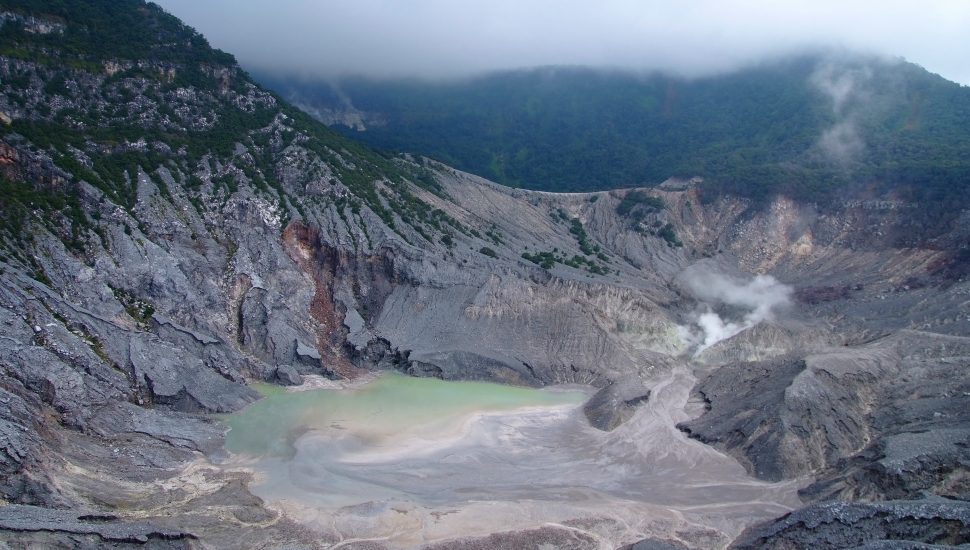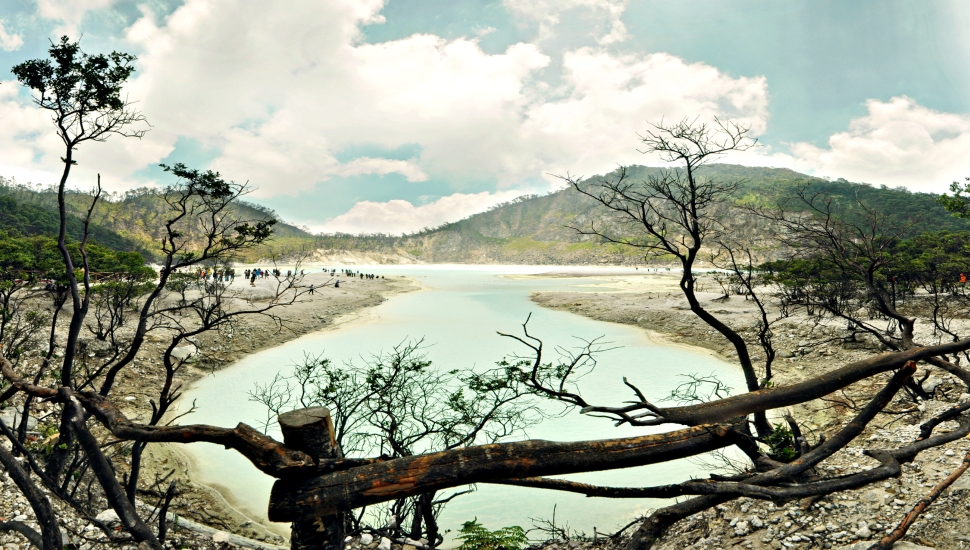The Volcanoes & Hot Springs of Bandung, Indonesia
After the vast urban sprawl of Jakarta, I hoped that Bandung, located 150km to the south west of the capital, would offer some tranquillity. Indonesia's second city, however, was a maze of roads at least as busy as those in Jakarta.
The four hour train ride couldn't have been less urban, presenting me and my travelling companion Lee with spectacular views of lush Javanese jungle and palm-clad mountains.
Arrival in Bandung brought the familiar flurry of taxi drivers offering to take us somewhere – no doubt for a much inflated fee. But unlike in some countries, here the swindling of tourists is a gentle, good-humoured affair.
We stopped in a cafe and used their Wi-Fi to check a hotel booking website. Instead of a hotel, we espied a hostel just a few blocks away. With the recent dramatic fall in the pound, we were both keen to economise.
Indeed, a bunk bed in Hostel Pirisi cost 90,000 rupiahs (£5.60) and included a cooked breakfast.
Tangkuban Perahu Volcano

My friend and I set out next day to visit Tangkuban Perahu, located to the north of Bandung. This would prove rather tricky. The city's public transport is largely based on angkots – mini vans which ferry people around for about 10,000 rupiahs a trip. Our first angkot delivered us safely to the bus terminal in the north of the city, but the next one only got us half as far as the driver promised.
Another driver in a clapped out yellow angkot agreed to take us to the top of Tangkuban Perahu for 80,000. This, we assumed, was still far higher than the going rate, but it wasn't worth wasting time arguing over a couple of pounds.
When we passed the gate at the foot of the volcano, we had to pay another 200,000 each (£12.50) which, even by Western standards, is expensive. Locals, by contrast, pay just 20,000 to get in.
However, as my very first experience of a volcano, it was worth it. We gazed down into the silty grey basin from which jets of white steam plumed upwards. We felt completely safe in Tangkuban Perahu, despite the fact that it had last erupted in 2013 and had blown its top more than a dozen times since 1826.
To our surprise, that evening in our dorm room we found a young Japanese man we had met briefly in Jakarta. Together we visited a local vegan restaurant, before sampling the local Bintang beer, over which we agreed to visit another volcano, Kawah Putih, the next day.
Kawah Putih Volcano

Kawah Putih (The White Crater), with its azure-blue sulphurous waters, is located 50km south of Bandung. Our research told us that getting there with public transport would prove time-consuming and rather hit-and-miss.
And so we decided to use Uber to reach our destination. It does seem strange to take an Uber to a volcano, but it appeared to be the most economical mode of transport.
After a few hiccups over connecting with a driver who could actually find the hostel, we were off. I had only used Uber once before, in Jakarta, so the process was a little mysterious. Later I would realise I should have understood the service better before using it; I had booked the trip to be paid for by card, but in the end paid in cash. As a result I paid twice as much for the trip than I should have!
Our driver, Muni, was only too pleased to take us to Kawah Putih. After a slow grind through Bandung's traffic-clogged suburbs, we were finally out in verdant jungle and perfectly manicured tea plantations. The sense that Indonesia is a developing nation is stronger outside its cities. At one point we passed a crowd gathered around something by the roadside; a small horse had tumbled over a ledge having detached from its cart and was being righted by its flustered owner.
Kawah Putih cost 60,000 to visit – a bargain considering it was far more impressive than Tangkuban Perahu. The lake inside the volcano was just as green-blue as the photos we had seen. The rotten egg smell of sulphur was rather strong, but didn't detract from the otherworldly beauty of the scene.
Kawah Rengganis Hot Springs
After Kawah Putih we asked Muni to take us to Kawah Rengganis (Cibuni), a hot spring a few kilometres away. He did so gladly – not surprising given the Uber clock was still running.
Kawah Rengganis was if anything even more ‘off-world' than Kawah Putih. A number of hot steaming pools studded a valley strewn with boulders and dense jungle. Jets of scalding steam shot out from under rocks. Little pools bubbled sulphurous vapour into the cool air. Locals beamed at us, the strange foreigners, as we stripped down to our shorts and stepped gingerly into one of these marvellous natural hot tubs.
Muni puffed away contentedly on a pungent clove cigarette as we submerged ourselves in the hot, healing waters of Kawah Rengganis. For our driver, taking a few travellers around these amazing sights was undoubtedly preferable to being stuck in Bandung's congested roads all day.
It had taken me several days to escape from urban Indonesia, but here, in the steaming pools of Kawah Rengganis, surrounded by jungle, I sensed I was going to like this country very much.
Get a Quote